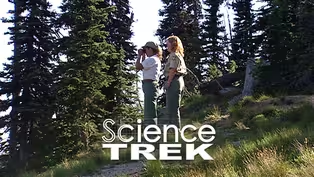
Forests: What Type is Your Forest?
Clip: Special | 1m 4sVideo has Closed Captions
What kind of trees are in your forest?
There are many different types of forests with different types of trees. Learn more about a few types of forests and the trees that populate them.
Problems playing video? | Closed Captioning Feedback
Problems playing video? | Closed Captioning Feedback
Science Trek is a local public television program presented by IdahoPTV
Major Funding by the Laura Moore Cunningham Foundation and the Idaho National Laboratory. Additional Funding by Sparklight, the Friends of Idaho Public Television and the Corporation for Public Broadcasting.

Forests: What Type is Your Forest?
Clip: Special | 1m 4sVideo has Closed Captions
There are many different types of forests with different types of trees. Learn more about a few types of forests and the trees that populate them.
Problems playing video? | Closed Captioning Feedback
How to Watch Science Trek
Science Trek is available to stream on pbs.org and the free PBS App, available on iPhone, Apple TV, Android TV, Android smartphones, Amazon Fire TV, Amazon Fire Tablet, Roku, Samsung Smart TV, and Vizio.

Science Trek
Science Trek is a place where parents, kids, and educators can watch short, educational videos on a variety of science topics. Every Monday Science Trek releases a new video that introduces children to math, science, technology, engineering, and math (STEM) career potentials in a fun, informative way.(SCIENCE TREK MUSIC) JOAN CARTAN-HANSEN, HOST: There are lots of different kinds of forests with all kinds of different trees.
There are deciduous forests.
Deciduous trees have leaves that turn color in the autumn and then fall off.
New leaves grow back in the spring.
There are coniferous forests.
A conifer is a tree with needles instead of leaves, and they don't drop off in the winter.
The one exception is the larch or tamarack tree.
This looks like a pine tree, but it's actually a deciduous tree.
The needles turn yellow in the autumn and drop off.
There are rain forests.
Here the soil has poor nutrients.
It has high average temperatures, and, you guessed it, a lot of rain fall.
But those conditions allow for amazing biological diversity.
The Amazon rain forests is home to 40 thousand plant species, 13 hundred bird species, and 2.5 million different types of insects.
There are the bamboo forests of China.
Bamboo stems are hollow, and they are a panda's favorite food.
And all the trees, no matter their kind, are important to the ecosystem.
For more information about forests, check out the Science Trek website.
You'll find it at ScienceTrek.org.
Video has Closed Captions
Clip: Special | 1m 4s | Find a science career in the trees. (1m 4s)
Providing Support for PBS.org
Learn Moreabout PBS online sponsorship
- Science and Nature

Explore scientific discoveries on television's most acclaimed science documentary series.

- Science and Nature

Capturing the splendor of the natural world, from the African plains to the Antarctic ice.












Support for PBS provided by:
Science Trek is a local public television program presented by IdahoPTV
Major Funding by the Laura Moore Cunningham Foundation and the Idaho National Laboratory. Additional Funding by Sparklight, the Friends of Idaho Public Television and the Corporation for Public Broadcasting.
